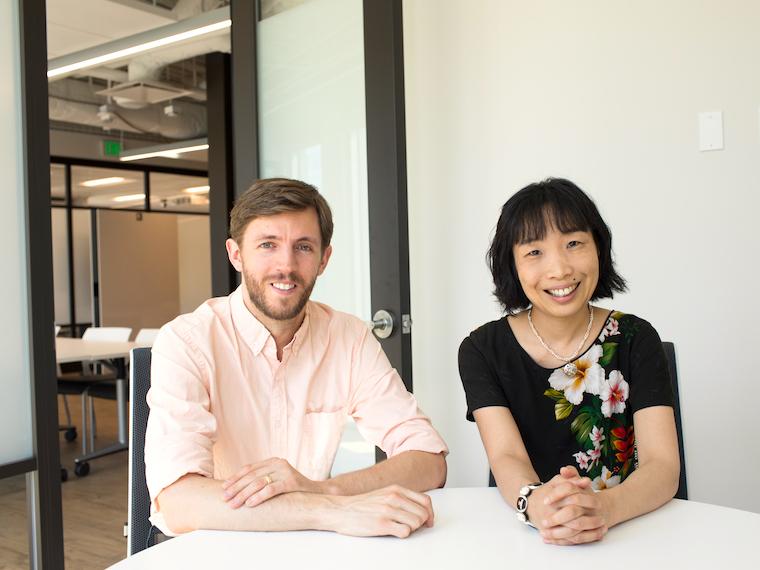Oberlin Center for Convergence (StudiOC)
No Art, No Voice?
What does “art” mean to indigenous and migrant peoples in a postcolonial world? Whose voices are we hearing when we consume “Gypsy” music or Ainu “folk” art? The courses in this learning community will highlight important parallels and differences in the ways in which expressive culture helps to orient people resiliently to particular places, environments, and challenges for survival.

Professors Ian MacMillen and Chie Sakakibara take a break in one of the small conference rooms in the StudiOC building.
Photo credit: Jennifer Manna
No Art, No Voice? Marginalized Cultures and the Arts of Survival
offered fall 2017
This learning community guides students in examining how expressive culture sustains marginalized indigenous and (formerly) migrant communities in three often conflicting ways: by preserving endangered insider knowledge and ways of living, by providing silenced groups with media to which dominant societies can relate, and by affording marketable commodities to the economically disadvantaged.
What does “art” mean to indigenous and migrant peoples in a postcolonial world? Whose voices are we hearing when we consume “Gypsy” music or Ainu “folk” art? How do social inequalities relate to environmental and racial justice, and is cultural knowledge preserved or lost in translation when these movements employ traditional arts?
Our learning community’s courses on marginalized cultures and the arts of survival will help students to understand the complex positions and nuanced artistic responses of peoples whose expressive culture does not merely function within their local communities but also is subject to the (mis)interpretations of dominant societies.
We will compare indigenous populations who have been marginalized through colonialism to formerly migrant populations who have lived primarily on the social margins since their settlement in Europe centuries ago. Together, the courses will highlight important parallels and differences in the ways in which expressive culture helps to orient people resiliently to particular places, environments, and challenges for survival.
Both of these courses are required for enrollment in the learning community.
Instructors
Faculty in the No Art, No Voice? learning community are Assistant Professor of Environmental Studies Chie Sakakibara and Assistant Professor of Russian and East European Studies Ian MacMillen, who also directs the college’s Center for Russian, East European and Central Asian Studies.
Chie Sakakibara
ENVS 327 Indigenous Environmentalism
Meets Thursdays, 11 am to 12:15 pm, 4 credit hours; enrollment limit 15.
Required course for the No Art, No Voice? Marginalized Cultures and the Arts of Survival learning community.
This seminar will investigate how the vitality of indigenous art is evidence of an extraordinary story of survival in the time of social, political, and environmental challenges. Through analyses of artworks and communication with indigenous artists from Japan and North America, we will explore how the visual arts have long played a critical role as carriers of cultural identity within global indigenous societies.
Their artistic imaginations are among the most eloquent articulations of identities and struggles for sovereignty, resilience, and environmentalism. The course will also elucidate the problems in how these arts have been represented in museums and scholarly writings.
Ian MacMillen, instructor
REES261 Roma, Gypsies, Travelers
Meets Monday, Wednesday, and Friday, 1:30-2:20 pm, 4 credit hours; enrollment limit 20.
Required course for the No Art, No Voice? Marginalized Cultures and the Arts of Survival learning community. Field trips also required.
Focusing largely but not exclusively on groups within Europe and its diasporas who identify as Roma, Sinti, Travelers, or Gypsies, this course considers how cultural notions of civilization, danger, and race arise through contact between majority populations and minority groups of marginal and/or migrant status.
Drawing comparisons to other minority and refugee groups, we will examine how Romani activists, anthropologists, and creators of cultural/historical archives have contributed to rights movements and will evaluate and qualify their results now at the conclusion of the European Union’s Decade of Romani Inclusion. The course involves an oral history project with local Roma Gypsy residents.